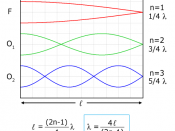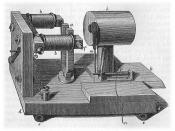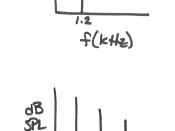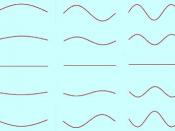Pipe Organ Assignment 1.
The last part of this statement refers to the air pressure inside the pipe is 500 to 1000 Pascal's. This refers to the amount of pressure that the air exerts on a manometer. A manometer measures pressure by measuring the pressure that is exerted on water that is contained in a U-shaped tube with an open end. As the pressure exerted on the manometer increases the water moves up the pipe. The last part of the statement refers to the air pressure acting on the foot of the pipe and how much the water is being displaced. In the case of the statement this is between 5 to 10 cm.
Figure 1: Schematic representations of (A) a differential manometer, (B) a Torricellian barometer, and (C) a siphon.
2.
If a pipe closed pipe attempts to resonate a particular frequency it only needs to be half as long as a pipe open at both ends.
This is because the resonance of a pipe is when there is maximum movement of air throughout an object. A pipe that is open only at one end has a first harmonic of a sound two times the fundamental while an open pipe has a first harmonic four times the fundamental frequency. This concept is demonstrated in the diagram on the right. Diagram (a) shows the 3rd harmonic in closed pipes, (b) shows the 2nd harmonic in closed pipes, (c) shows the 1st harmonic in closed pipes, (d) shows the 1st harmonic in open pipes and (e) shows the 2nd harmonic in open pipes.
3.
Stopped pipes sound hollow because there is reflection of the sound wave. These reflections of a sound cause the high frequency sounds to be lost and only the mid-range and lower frequencies to be heard. Higher frequency sounds also diffract less than mid and low frequencies and hence they are not reflected effectively and are stopped by the closed end of the pipe.
In open pipes, the sound is brighter because the sound is not reflected down the pipe, it travels straight through and therefore allows the higher frequency sounds to be heard. Higher frequency sounds sound brighter because there is less destructive interference when sound wave pass straight through than when reflected. This is because the closed pipes only allow odd-numbered resonant peaks and therefore suppresses all the even numbered harmonics of the fundamental. Open pipes however respond to all harmonics of a particular fundamental.
In the diagrams below one can see that in the open pipe it allows the sound to travel straight through the pipe, while in the closed pipe the sound is reflected.
4.
The acoustic behavior of pipes is strange because it is energy loss that determines how pipes resonate. Pipes have two types of losses; these ways is through viscous and heat conduction loss to the pipe walls and the other way is radiation loss from the mouth of the pipe to the open end. Energy loss of heat conduction is more prevalent in narrow pipes at low frequencies. Radiation loss is prevalent in wide pipes at high frequencies. Because of these effects, wide pipes are good resonators for low frequencies and its first few harmonics and sound dull and "fluty"ÃÂ. Narrow pipes are good resonators for a large number of harmonics, but higher harmonics are resonated better than lower ones because the low frequencies sound thin and "stringy"ÃÂ. In between these problems with the extremes of the pipes, there are pipes that are bright and have good ringing characteristics and these pipes are called principles or diapasons.
Bibliography Encyclopedia Britannica, http://www.britannica.com Pipe organ Hand-out





